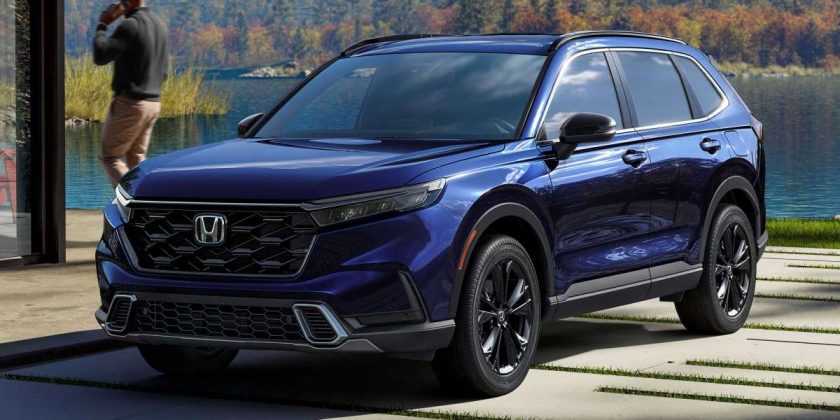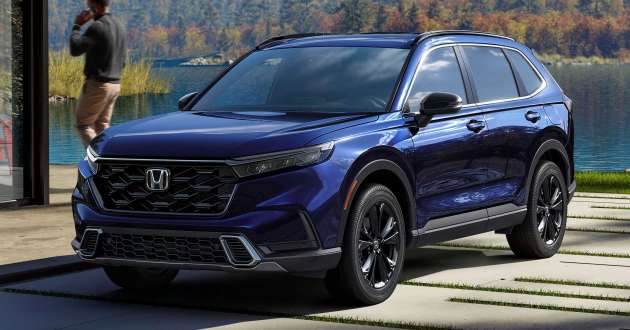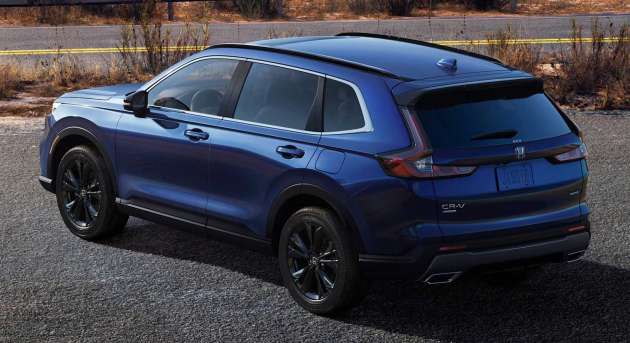Honda has just unveiled the sixth-generation CR-V, which has been completely redesigned and will go on sale for the 2023 model year in the United States this summer (between June and August). Initially, the brand’s all-new SUV will be offered with turbo power before hybrid variants are introduced later in the year.
The EX and EX-L variants will get an updated version of the 1.5 litre VTEC Turbo engine, which Honda claims is better refined while providing improved emissions performance. Notable enhancements to the four-cylinder mill include a new high-efficiency, high-response turbocharged as well as a 4-2 exhaust port cylinder head.
Outputs remain unchanged despite these revisions, with the engine churning out 190 hp (193 PS) and 243 Nm of torque, although these arrive at different engine speeds compared to before. In the case of peak horsepower, it now arrives 400 rpm later at 6,000 rpm, while peak torque now arrives 300 rpm earlier from 1,700 to 5,000 rpm. The VTEC Turbo continues to be paired with a CVT, which also gets tweaks to reduce noise and vibration.
As for the hybrid powertrain, it can only be had with Sport and Sport Touring variants. The setup is similar to what you’ll find in the latest Civic e:HEV, with a 2.0 litre Atkinson cycle four-cylinder engine and e-CVT working together with two electric motors for a total system output of 204 hp (207 PS).
It should be noted the quoted figure is less than the outgoing model that was rated at 212 hp (215 PS). However, one of the electric motors (not the one that acts as a generator for the battery) is actually torquier than before, generating 335 Nm instead of 315 Nm. The new hybrid powertrain also earns the CR-V a tow rating of 454 kg (1,000 pounds) where the previous one didn’t get a figure at all.
All variants can be optioned with all-wheel drive (marketed as Real Time AWD with Intelligent Control System), with the system now able to send 50% of engine torque to the rear wheels for better traction in slippery conditions like snow and mud – the Sport Touring gets this as standard. In terms of drive modes, there are three standard selectable options (Normal, Econ and a new Snow), with Sport being an additional mode for hybrid variants.
Other mechanical revisions include a stiffer front subframe and repositioned steering rack to improve feel and accuracy. The rear subframe also gets stiffened for the re-tuned multilink suspension which features a 15% higher spring rate for the upper spring mount – MacPherson struts continue to be used at the front.
Styling-wise, the latest CR-V ditches the curvy shape of its predecessor for a sharper, more rugged look. The bolder appearance is said to be inspired by the recently redesigned Ridgeline and Passport TrailSport, with key cues being the large, upright gloss black grille that is flanked by slim LED headlamps.
The angular bumper is also new, and on hybrid variants, it features a wide lower intake with chrome accents and L-shaped elements that integrate what appears to be vertical air slits. Non-hybrid models get a tamer look that illustrated by the red car in the gallery below.
You’ll also notice the longer bonnet, which is a result of the A-pillars being moved rearwards by some 119 mm. The base of the A-pillars has also been moved 71 mm outward and sit 35.6 mm lower than the previous CR-V.
Along the sides, a prominent beltline highlights the reshaped window line that has a less pronounced kink near the base of the D-pillars, accompanied by familiar lower body cladding. Moving to the rear, we find vertical taillights that are a nod to the outgoing model, although they are sleeker in appearance on the new SUV.
The reprofiled tailgate also sees the number plate being placed higher up, with the lower recessed section omitted entirely. Those rectangular exhaust finishers are only fitted to Sport and Sport Touring variants, both of which also get 18-inch and 19-inch black alloys respectively – the EX and EX-L settle for 18-inch silver units instead.
If the new CR-V looks larger than its predecessor, your eyes aren’t deceiving you. The sixth-gen model measures 4,694 mm long (+69 mm) and 1,864 mm wide (+10 mm), while the height is just slightly reduced to 1,681 mm (-8 mm). Of more significance is the wheelbase, which has grown by 40 mm to span 2,700 mm.
The wider gap between the wheels means there’s more rear seat legroom (+15 mm), and the bench now features eight angles of recline for increased comfort. Other benefits include a larger front-to-rear-seat couple distance and more cargo room in both turbo and hybrid variants.
Also on the inside is the Civic-inspired dashboard that was revealed days before today’s official debut. Much of the design is almost a carbon copy of the sedan, including the three-spoke steering wheel, full-width mesh-covered air vents and freestanding infotainment touchscreen, the last of which measures seven inches in the EX and Sport, and nine inches in the EX-L and Sport Touring.
One area that differs from the Civic is the centre console, which is larger in the CR-V given the SUV’s overall size. This allows the gear lever to be placed side-by-side with the drive mode selector, hill descent control button and electronic parking brake switch. These items are placed aft of a storage cubby that integrates a Qi wireless charger (EX-L and Sport Touring only), with a pair of cupholders sandwiched between the raised centre console and armrest.
All variants of the CR-V come with support for Android Auto and Apple CarPlay, with wireless connectivity being reserved for EX-L and Sport Touring variants. A seven-inch digital instrument cluster is part of the basic kit list too, as is 10 airbags, hill descent control, rear seatbelt reminder, rear seat reminder and driver attention monitor and Honda Sensing.
The suite of safety and driver assistance systems is now supported by a new 90-degree field of view camera and 120-degree field of view millimetre-waveradar, with additional functions being new Traffic Jam Assist (TJA), Low-Speed Braking Control and Traffic Sign Recognition (TSR). Blind spot information (BSI) is now standard, and existing features such as Adaptive Cruise Control (ACC) with Low-Speed Follow and Lane Keeping Assist (LKAS) are now capable of more natural responses.
Cloth upholstery is included in EX and Sport variants, while leather is used in the EX-L and Sport Touring. The hybrids also get two additional USB-C ports for rear passengers on top of the USB-A and USB-C ports at the front of the cabin, while the range-topping option is the only one with a 12-speaker Bose sound system.
So, there you have it, the all-new CR-V? Are you impressed by the SUV’s new look, or do you prefer its predecessor? Are you hoping we get the redesigned SUV with the hybrid powertrain? Share your thoughts in the comments below.
Source: Read Full Article






